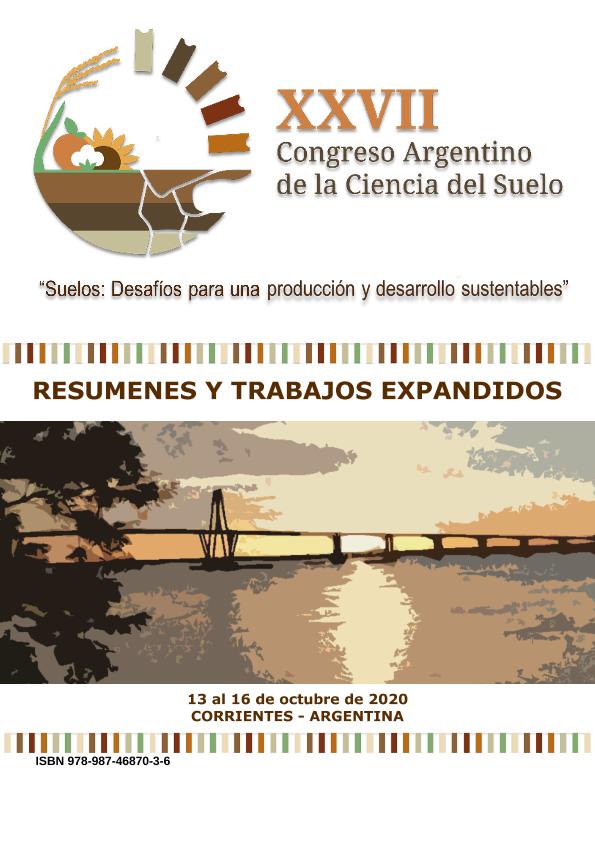Mostrar el registro sencillo del ítem
dc.contributor.author
Suñer, Liliana

dc.contributor.author
Duval, Matias Ezequiel

dc.contributor.author
Martinez, Juan Manuel

dc.contributor.author
Iglesias, Julio Osvaldo

dc.contributor.author
Galantini, Juan Alberto

dc.date.available
2022-11-03T16:18:14Z
dc.date.issued
2020
dc.identifier.citation
Visible and infrared spectroscopy in soils under cultivated and natural systems; XXVII Congreso Argentino de la Ciencia del Suelo. Suelos: Desafíos para una producción y desarrollo sustentables; Corrientes; Argentina; 2020; 236-241
dc.identifier.isbn
978-987-46870-3-6
dc.identifier.uri
http://hdl.handle.net/11336/176264
dc.description.abstract
The soil organic carbon (SOC) and its different fractions are soil parameters highly influenced by management practices. Studies based on spectroscopic techniques are currently used, since they constitute a valuable tool to obtain information on the structural elucidation of many molecules, which allow interpretation of organic matter characteristics. The objective of this study was to evaluate the effect of different soil management practices: to determine the molecular changes in the organic forms with spectral technical along a gradient of sites with different soil textures and climate conditions. In three study sites (Bengolea (BE), Monte Buey (MB) and Pergamino (PER), with documented history of NT management located across a West-East transect in the most productive region in the Argentinean pampas were applied three treatments studied: ‘‘Good Agricultural Practices’’ (GAP), ‘‘Poor Agricultural Practices’’ (PAP) and ‘‘Natural Environment’’ (NE). E4/E6 index were determined by UV–visible spectroscopy and with IR spectroscopy the main peaks were compared and determined the ratio between them. The E4/E6 ratios showed the tendency: NE>GAP>PAP for all studied sites, this order is associated with the increase in the molecular condensation and the aromaticity, which are proportional to the humification degree and the stability of the system studied. The sequence of the aromaticity degree (1650/2920) obtained from the absorbance ratios of the IR spectra in the samples analyzed was MB>BE>PER in natural and cultivated soils it could associates with contained of coarse particulated organic carbon fraction. The sequence of the polycondensation degree (1034/1540) obtained from the absorbance rate of the IR spectra in the samples analyzed was. BE>MB>PER, it could be indicated that polycondensation degree it could be related with fine particulate organic carbon fraction in natural and cultivate soils. Analyzing the 1380/1620 ratios, these bands correspond to different vibration modes of the carboxyl group. The values of such rate were similar among sites MB ≈ BE ≈ PER it could be associated with soil potential fertility (ratio soil organic carbon versus (silt+ clay)) in natural and cultivated soils. As a conclusion, soil management produced biochemical quality changes on organic forms, which would modify the predominant functional group. In all study sites, the E4/E6 relationships was in order NE/GAP/PAP indicating it was sensitive to management practices. The relationships among the main IR peaks could indicated the presence of determinate C fraction.
dc.format
application/pdf
dc.language.iso
eng
dc.publisher
Asociación Argentina de la Ciencia del Suelo
dc.rights
info:eu-repo/semantics/openAccess
dc.rights.uri
https://creativecommons.org/licenses/by-nc-sa/2.5/ar/
dc.subject
SOIL MANAGEMENT
dc.subject
HUMIC SUBSTANCES
dc.subject
CARBON FRACTIONS
dc.subject.classification
Ciencias del Suelo

dc.subject.classification
Agricultura, Silvicultura y Pesca

dc.subject.classification
CIENCIAS AGRÍCOLAS

dc.title
Visible and infrared spectroscopy in soils under cultivated and natural systems
dc.type
info:eu-repo/semantics/publishedVersion
dc.type
info:eu-repo/semantics/conferenceObject
dc.type
info:ar-repo/semantics/documento de conferencia
dc.date.updated
2022-06-08T19:28:26Z
dc.journal.pagination
236-241
dc.journal.pais
Argentina

dc.journal.ciudad
Buenos Aires
dc.description.fil
Fil: Suñer, Liliana. Provincia de Buenos Aires. Gobernación. Comisión de Investigaciones Científicas; Argentina. Consejo Nacional de Investigaciones Científicas y Técnicas. Centro Científico Tecnológico Conicet - Bahía Blanca. Centro de Recursos Naturales Renovables de la Zona Semiárida. Universidad Nacional del Sur. Centro de Recursos Naturales Renovables de la Zona Semiárida; Argentina
dc.description.fil
Fil: Duval, Matias Ezequiel. Universidad Nacional del Sur. Departamento de Agronomía; Argentina. Consejo Nacional de Investigaciones Científicas y Técnicas. Centro Científico Tecnológico Conicet - Bahía Blanca. Centro de Recursos Naturales Renovables de la Zona Semiárida. Universidad Nacional del Sur. Centro de Recursos Naturales Renovables de la Zona Semiárida; Argentina
dc.description.fil
Fil: Martinez, Juan Manuel. Universidad Nacional del Sur. Departamento de Agronomía; Argentina. Consejo Nacional de Investigaciones Científicas y Técnicas. Centro Científico Tecnológico Conicet - Bahía Blanca. Centro de Recursos Naturales Renovables de la Zona Semiárida. Universidad Nacional del Sur. Centro de Recursos Naturales Renovables de la Zona Semiárida; Argentina
dc.description.fil
Fil: Iglesias, Julio Osvaldo. Universidad Nacional del Sur. Departamento de Agronomía; Argentina
dc.description.fil
Fil: Galantini, Juan Alberto. Consejo Nacional de Investigaciones Científicas y Técnicas. Centro Científico Tecnológico Conicet - Bahía Blanca. Centro de Recursos Naturales Renovables de la Zona Semiárida. Universidad Nacional del Sur. Centro de Recursos Naturales Renovables de la Zona Semiárida; Argentina. Provincia de Buenos Aires. Gobernación. Comisión de Investigaciones Científicas; Argentina
dc.relation.alternativeid
info:eu-repo/semantics/altIdentifier/url/http://www.suelos.org.ar/sitio/cacs-2020-descarga-de-contribuciones/
dc.conicet.rol
Autor

dc.conicet.rol
Autor

dc.conicet.rol
Autor

dc.conicet.rol
Autor

dc.conicet.rol
Autor

dc.coverage
Nacional
dc.type.subtype
Congreso
dc.description.nombreEvento
XXVII Congreso Argentino de la Ciencia del Suelo. Suelos: Desafíos para una producción y desarrollo sustentables
dc.date.evento
2020-10-13
dc.description.ciudadEvento
Corrientes
dc.description.paisEvento
Argentina

dc.type.publicacion
Book
dc.description.institucionOrganizadora
Asociación Argentina de la Ciencia del Suelo
dc.source.libro
XXVII Congreso Argentino de la Ciencia del Suelo. Suelos: Desafíos para una producción y desarrollo sustentables
dc.date.eventoHasta
2020-10-16
dc.type
Congreso
Archivos asociados
